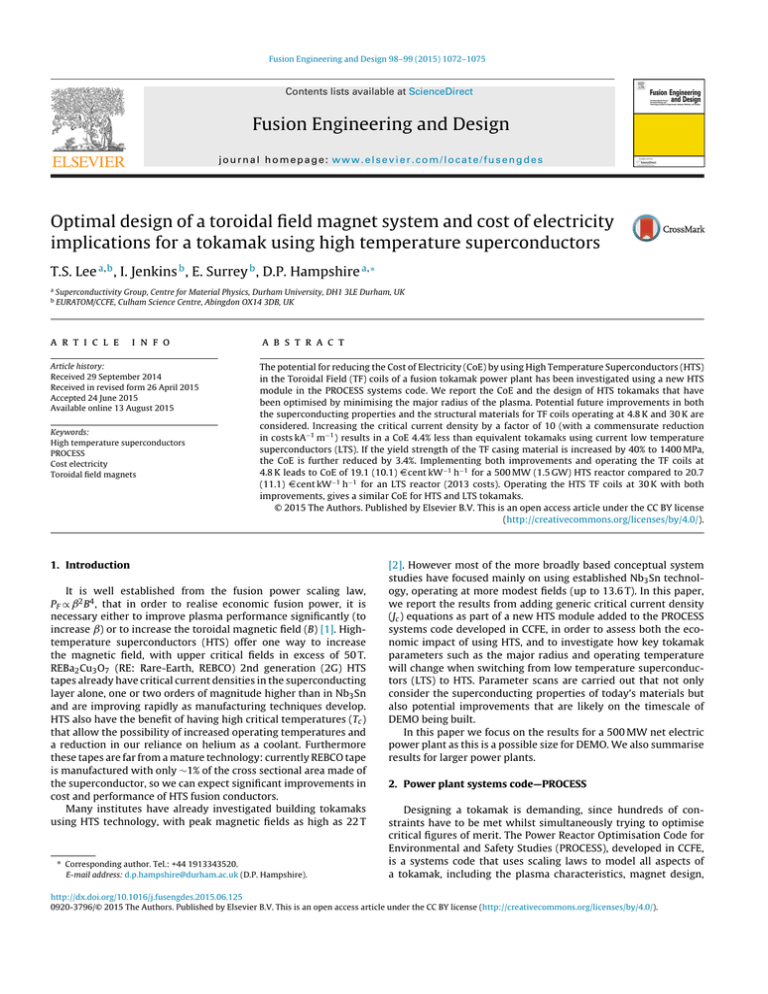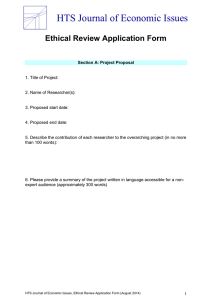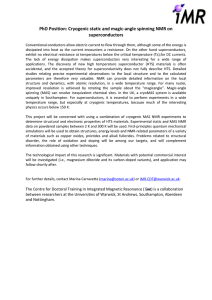Optimal design of a toroidal field magnet system and cost of
advertisement

Fusion Engineering and Design 98–99 (2015) 1072–1075 Contents lists available at ScienceDirect Fusion Engineering and Design journal homepage: www.elsevier.com/locate/fusengdes Optimal design of a toroidal field magnet system and cost of electricity implications for a tokamak using high temperature superconductors T.S. Lee a,b , I. Jenkins b , E. Surrey b , D.P. Hampshire a,∗ a b Superconductivity Group, Centre for Material Physics, Durham University, DH1 3LE Durham, UK EURATOM/CCFE, Culham Science Centre, Abingdon OX14 3DB, UK a r t i c l e i n f o Article history: Received 29 September 2014 Received in revised form 26 April 2015 Accepted 24 June 2015 Available online 13 August 2015 Keywords: High temperature superconductors PROCESS Cost electricity Toroidal field magnets a b s t r a c t The potential for reducing the Cost of Electricity (CoE) by using High Temperature Superconductors (HTS) in the Toroidal Field (TF) coils of a fusion tokamak power plant has been investigated using a new HTS module in the PROCESS systems code. We report the CoE and the design of HTS tokamaks that have been optimised by minimising the major radius of the plasma. Potential future improvements in both the superconducting properties and the structural materials for TF coils operating at 4.8 K and 30 K are considered. Increasing the critical current density by a factor of 10 (with a commensurate reduction in costs kA−1 m−1 ) results in a CoE 4.4% less than equivalent tokamaks using current low temperature superconductors (LTS). If the yield strength of the TF casing material is increased by 40% to 1400 MPa, the CoE is further reduced by 3.4%. Implementing both improvements and operating the TF coils at 4.8 K leads to CoE of 19.1 (10.1) D cent kW−1 h−1 for a 500 MW (1.5 GW) HTS reactor compared to 20.7 (11.1) D cent kW−1 h−1 for an LTS reactor (2013 costs). Operating the HTS TF coils at 30 K with both improvements, gives a similar CoE for HTS and LTS tokamaks. © 2015 The Authors. Published by Elsevier B.V. This is an open access article under the CC BY license (http://creativecommons.org/licenses/by/4.0/). 1. Introduction It is well established from the fusion power scaling law, PF ∝ ˇ2 B4 , that in order to realise economic fusion power, it is necessary either to improve plasma performance significantly (to increase ˇ) or to increase the toroidal magnetic field (B) [1]. Hightemperature superconductors (HTS) offer one way to increase the magnetic field, with upper critical fields in excess of 50 T. REBa2 Cu3 O7 (RE: Rare-Earth, REBCO) 2nd generation (2G) HTS tapes already have critical current densities in the superconducting layer alone, one or two orders of magnitude higher than in Nb3 Sn and are improving rapidly as manufacturing techniques develop. HTS also have the benefit of having high critical temperatures (Tc ) that allow the possibility of increased operating temperatures and a reduction in our reliance on helium as a coolant. Furthermore these tapes are far from a mature technology: currently REBCO tape is manufactured with only ∼1% of the cross sectional area made of the superconductor, so we can expect significant improvements in cost and performance of HTS fusion conductors. Many institutes have already investigated building tokamaks using HTS technology, with peak magnetic fields as high as 22 T ∗ Corresponding author. Tel.: +44 1913343520. E-mail address: d.p.hampshire@durham.ac.uk (D.P. Hampshire). [2]. However most of the more broadly based conceptual system studies have focused mainly on using established Nb3 Sn technology, operating at more modest fields (up to 13.6 T). In this paper, we report the results from adding generic critical current density (Jc ) equations as part of a new HTS module added to the PROCESS systems code developed in CCFE, in order to assess both the economic impact of using HTS, and to investigate how key tokamak parameters such as the major radius and operating temperature will change when switching from low temperature superconductors (LTS) to HTS. Parameter scans are carried out that not only consider the superconducting properties of today’s materials but also potential improvements that are likely on the timescale of DEMO being built. In this paper we focus on the results for a 500 MW net electric power plant as this is a possible size for DEMO. We also summarise results for larger power plants. 2. Power plant systems code—PROCESS Designing a tokamak is demanding, since hundreds of constraints have to be met whilst simultaneously trying to optimise critical figures of merit. The Power Reactor Optimisation Code for Environmental and Safety Studies (PROCESS), developed in CCFE, is a systems code that uses scaling laws to model all aspects of a tokamak, including the plasma characteristics, magnet design, http://dx.doi.org/10.1016/j.fusengdes.2015.06.125 0920-3796/© 2015 The Authors. Published by Elsevier B.V. This is an open access article under the CC BY license (http://creativecommons.org/licenses/by/4.0/). T.S. Lee et al. / Fusion Engineering and Design 98–99 (2015) 1072–1075 balance of plant etc. In doing so, it is possible to find an optimal design for a nuclear fusion power plant. PROCESS is a powerful tool as the simple scaling laws require very little computational power allowing parameter scans of key tokamak parameters with 16 processor clusters in a few minutes. Previous work (e.g. the PPCS study [3]) using PROCESS included investigations into the constraints on the plasma and technology performance and analysis of relatively near term increases in the plasma and technology performance as compared with ITER. We have been guided by that previous work to set key parameters as follows: ˇN ∼ 3.0, the plant availability set at 0.75, the calculated bootstrap current fraction ∼35%, the efficiency of converting the thermal power into electrical power of 40% and a peak divertor heat load of 10 MW m−2 . Further details of the technological assumptions made in this paper can be found in the PPCS study and in a recent PROCESS update [4]. We have also assumed a learning factor of 0.65, equivalent to a 10th of a kind reactor. For the superconductors we used costs of 6.1 and 80.6 $ kA−1 m−1 at 12 T, 4.2 K for Nb3 Sn and REBCO respectively, which are 1990 ¢ costs calculated retrospectively for use in the 1990 cost module in PROCESS. In principle, increases in Jc and reductions in cost of HTS tapes occur separately. Influenced by the low cross sectional area of superconductor in HTS tapes compared to LTS strands and to simplify our analysis, we have chosen to consider increases in Jc at constant cost per unit length (i.e. when Jc doubles, the cost kA−1 m−1 halves). We also convert 1990 ¢ costs to 2013 D cent costs using CPI inflation where 1 ¢ (1990) = 1.32 D cent (2013). 3. Critical currents in superconductors PROCESS describes the reduced field b = B/Bc2 , reduced tem- C q Jc = s (ε) 1 − t 1.52 1 − t 2 bp (1 − b) B be ∼2. The (strain independent) upper critical field (Bc2 ) was taken to be: Bc2 = Bc2 (0) 1− T 0.61 (4) Tc where Tc is 87.6 K and Bc2 (0) is 68.5 T for HTS [7]. Current values of Jc were taken to be 7.8 and 3.2 × 108 A m−2 at 12 T and 4.2 K for LTS strands and HTS tapes respectively. Improvements in Jc are implemented by changing the values of C (LTS materials) and U (HTS materials) associated with ˛(T). In PROCESS, we set the maximum operating current to 50% of Jc . The heat loads in the cryogenic system, are scaled from ITER values, whilst assuming no additional AC losses as we are investigating steady state tokamak devices. 4. Results 4.1. Optimum operating temperature for TF coils Fig. 1 shows the Cost of Electricity (CoE) that has been found by minimising the major radius of the plasma torus for a 500 MW net electricity tokamak operating at a given coolant temperature—using either Nb3 Sn or REBCO as the superconductor in the TF coils. For Nb3 Sn, the optimum operating temperature is in the liquid helium range (∼2.5 K) with a corresponding CoE of 15.3 ¢ kW−1 h−1 and peak operating magnetic field of ∼13.5 T. Although the assumptions made about cryoplant efficiency at very low temperatures do affect the optimum operating temperature itself, because the cost of electricity is only weakly dependent on operating temperature as shown in Fig. 1, the important conclusions of the paper are unaffected. ITER will operate at 4.8 K so that it can use supercritical helium as the coolant. If present-day REBCO were to be used as the superconductor in the TF coils, the opti14 120 -1 13 100 12 -1 exp − (2) The form of the field and temperature dependencies follow those reported for flux flow along channels [6,7]. We also include an empirical strain dependence in Eq. (2) to provide a generic parameterisation of Jc . The free parameters ˛ (T ), c (T ), ε0 (T ), and ˇW (T ) are taken as functions of temperature alone and fitted using variable strain Jc data from Sunwong [7] and Sugano [8] in the form: f (T ) = U 1 − T Tc V , (3) where Tc is independent of strain. The values of the constants U and V for REBCO tape are shown in Table 1. The constant d was found to Table 1 The values of U and V for REBCO derived from experimental data [7,8] for ˛(T), c(T), ε0 (T), and ˇW (T) using Eq. (3). U ˛(T) c(T) ε0 (T) ˇW (T) 40 9 Nitrogen B cos ˇW (T ) Neon Helium B Bc2 Hydrogen × 1− 10 60 8 7 20 6 0 0 10 20 30 40 50 60 70 5 TF Coil Operating Temperature (K) 14 Nb 3 Sn 19 -1 11 80 13 -1 Jc ≈ ˛ (T ) 1 − c (T ) (ε − ε0 (T ))d Cost of Electricity (¢ kW h ) where all symbols have their usual meanings. In the new HTS module, Jc of tapes is described as a function of field (B), temperature (T), angle of the field with respect to the tape and strain, using: 18 12 17 11 16 15 10 1 2 3 4 5 6 7 8 9 10 Peak Toroidal Magnetic Field (T) (1) Peak Toroidal Magnetic Field (T) REBCO Cost of Electricity (¢ kW h ) perature t = T/Tc and strain (ε) dependence of the critical current density (Jc ), more strictly the engineering (or whole strand) critical current density, of Nb3 Sn strand using [5]: 1073 9 TF Coil Operating Temperature (K) V 11 (1.08 ± 0.03) × 10 0.025 ± 0.003 −0.51 ± 0.04% 13.8 ± 0.2 T A m −2 2.0 −1.200 1.09 0.42 ± ± ± ± 0.1 0.005 0.08 0.03 Fig. 1. The cost of electricity in 1990 $ that has been found by minimising the major radius of a 500 MW net electricity tokamak operating at a given coolant temperature. The equivalent peak toroidal magnetic field is also shown. The TF coils are constructed using the superconductors (a) REBCO and (b) Nb3 Sn. For (a) the temperature range over which some cryogens are liquid is shown. 1074 T.S. Lee et al. / Fusion Engineering and Design 98–99 (2015) 1072–1075 17.5 17.0 J c x 10 J c x 20 20 18 16 14 0 10 20 30 40 50 TF Coil Operating Temperature (K) 16.0 -1 Nb 3 Sn Jc x 1 -1 Jc x 2 17 14 12 800 1200 1600 2000 Yield Strength (MPa) 15.0 14.5 REBCO 4.8 K 13.5 800 Jc x 5 16 15.5 14.0 18 Cost of Electricity (¢ kW h ) 16.5 CSUS-JN1 Jc x 5 22 Cost of Electricity (¢ kW -1 h -1 ) Jc x 2 ITER 24 18 Peak Field (T) REBCO Jc x 1 -1 -1 Cost of Electricity (¢ kW h ) 26 30 K Jc x 5 Jc x 5 Jc x 10 Jc x 10 Jc x 20 Jc x 20 Nb3Sn Jc x 1 Jc x 2 1200 1600 2000 Yield Strength (MPa) 16 Fig. 3. The cost of electricity in 1990 $ of a 500 MW fusion power plant as a function of the yield strength of the steel used to construct the TF coil casing. Results are plotted for Nb3 Sn and for REBCO at different values of Jc (where Jc × 2 refers to twice its current value). The peak operating field for the different superconductors is shown in the top right corner. The yield strength of structural materials for ITER is shown as well as the yield strength of the cryogenic steel, CSUS-JN1 [9]. 15 14 1 2 3 4 5 6 7 8 9 10 TF Coil Operating Temperature (K) Fig. 2. The cost of electricity in 1990 $ that has been found by minimising the major radius of a 500 MW net electricity tokamak operating at a given coolant temperature. The TF coils are constructed using the superconductors (a) REBCO and (b) Nb3 Sn. The effect of increasing the critical current density in both superconductors is shown. mum operating temperature would nominally be ∼2 K giving a CoE of 18.3 ¢ kW−1 h−1 , about 20% higher than Nb3 Sn. This CoE rises rapidly as the operating temperature of the TF coils increases due to the large capital cost of buying more REBCO tape. 4.2. Improvements in the critical current density Given the likely improvements in REBCO, we have investigated how the CoE of a tokamak is changed as Jc of REBCO and Nb3 Sn improves as shown in Fig. 2. For Nb3 Sn, an improvement by a factor of 2 in the critical current density reduces the cost of electricity from 15.3 ¢ kW−1 h−1 to 15.0 ¢ kW−1 h−1 . The optimum operating temperature is also increased slightly to 3.7 K. However, increases in Jc for Nb3 Sn beyond a factor 2 have little commercial value, showing only marginal improvements in the CoE, as stress constraints for the magnets become important. The extensive use of Nb3 Sn to build ITER means that the manufacture of Nb3 Sn conductors is now a mature technology and improvements in Jc beyond today’s values will be difficult. For REBCO however significant increases in Jc are likely. An improvement by a factor 5 would make the CoE for HTS competitive with Nb3 Sn. An improvement in Jc of 10 is needed to give similar CoE at 30 K where other benefits such as using resistive joints that enable demountable magnets, better availability and using neon rather than helium as the coolant, provide benefits not included in the CoE calculated in this work. the UTS (1500 MPa) which sets a maximum von Mises stress of 667 MPa on the TF coil casing. In light of well-established cryogenic steels with yield strengths above 1400 MPa and UTS approaching 1800 MPa [9], this work considers the impact of improved yield strengths for future materials without changes in cost that range from 800 to 2000 MPa at the operating temperature. Fig. 3 shows the effect on the CoE of increasing Jc and increasing the yield strength of the TF coil casing. For LTS operating at 4.8 K and HTS at 30 K, there is little value in improving the structural materials used, because of the small reduction in the CoE for improvements in steel strength. This is because in LTS the field dependence of Jc (i.e. low Bc2 ) limits the attainable magnetic field and for HTS at 30 K, large quantities of expensive REBCO tape are needed to reach high fields. For HTS at 4.8 K however, savings of ∼3.4% can be made for a 40% increase in the steel strength assuming an increase in Jc by a factor 10. For HTS at 4.8 K, an increase by a factor 5 is needed in Jc in order to be competitive with LTS whereas to operate at 30 K, an increase by a factor of 10 is required. Table 2 shows some of the key tokamak parameters for the different 500 MW power plants considered in this paper. In an advanced HTS fusion plant where Jc has increased by a factor of 10 over today’s values and high-strength cryogenic steels are used, the CoE for a HTS tokamak operating at 4.8 K is 7.7% lower than an equivalent LTS machine. The HTS plant has a peak field of 15.8 T, a major radius 8.6% lower and a plasma density 32% higher than the LTS plant. These improvements also lead to the added benefit of lower required plasma currents and higher bootstrap fractions of the current. Alternatively the HTS tokamak can be operated at 30 K and the CoE is comparable to LTS. 4.4. Optimised gigawatt tokamaks 4.3. REBCO TF casing strength For tokamaks operating at magnetic fields higher than ITER, the yield strength (YS) and the ultimate tensile stress (UTS) eventually become the critical design parameters in the TF coils. In PROCESS, the allowable stress on the casing of the TF coils is the minimum of 2/3 the yield strength (normally taken to be 1000 MPa) or 1/2 We have repeated the analysis above for tokamaks larger than 500 MW. Table 3 gives a summary of the costs of electricity for 500 MW, 1000 MW and 1500 MW net electricity fusion reactors. It compares CoE calculated using present day values for the Jc and allowable stress on the TF coil casing as well as values that include possible future improvements. From Table 3, the CoE (in T.S. Lee et al. / Fusion Engineering and Design 98–99 (2015) 1072–1075 1075 Table 2 Key tokamak parameters for five 500 MW power plants. LTS—Nb3 Sn in the TF coils. HTS—REBCO (at 4.8 K) in the TF coils with Jc × 10. HTS + s/s—REBCO (at 4.8 K) for the TF coils with Jc × 10 and TF coil steel strength × 1.4. HTS 30 K and HTS + s/s 30 K as before but with TF coils at 30 K. TF operating temp (K) Fusion power (GW) Major radius (m) Peak magnetic field (T) Field on axis (T) Average Density (1019 m−3 ) Plasma current (MA) Bootstrap Fraction CoE (D cent kW−1 h−1 ) LTS HTS HTS + s/s HTS 30 K HTS + s/s 30 K 4.8 2.6 7.67 12.6 4.4 8.7 23.5 0.35 20.7 4.8 2.6 7.42 14.2 5.3 10.1 21.3 0.37 19.8 4.8 2.6 7.01 15.8 5.9 11.5 20.3 0.39 19.1 30 2.6 7.47 14.0 5.3 10.0 21.4 0.37 20.9 30 2.6 7.06 15.6 5.8 11.3 20.4 0.38 20.6 Table 3 The cost of electricity (2013) for tokamaks with a net electrical power of 500 MW, 1000 MW and 1500 MW. Nb3 Sn and REBCO are considered for the TF coils with different improvements in Jc and steel strength. Cost of electricity (D cent kW−1 h−1 2013 costs) Nb3 Sn Nb3 Sn × 2Jc , ×1.4 s/s REBCO × 2Jc , 4.8 K REBCO × 10Jc , 4.8 K REBCO × 10Jc , ×1.4 s/s, 4.8 K REBCO × 10Jc , 30 K REBCO × 10Jc , ×1.4 s/s, 30 K 500 MW 1 GW 1.5 GW 20.7 19.6 21.8 19.8 19.1 20.9 20.6 13.4 12.6 13.9 12.8 12.3 13.4 13.0 11.1 10.3 11.4 10.6 10.1 11.0 10.6 D cent kW−1 h−1 2013 costs) for HTS fusion energy plants decreases as the plant gets larger where: CoE = L(P)n , (5) where P is the electric power of the plant in GW, L varies from 14.3 for current materials down to 12.6 for advanced materials (cf. 1 GW data in Table 3) and n = −0.59. To obtain some indication of the relative merits of fusion as a power source, we note that the strike price for the new Hinkley point C nuclear fission reactor in the UK is set at 9 pence kW−1 h−1 which is equivalent to ∼11.5 D cent kW−1 h−1 in 2013 costs, not dissimilar to the 1.5 GW plant with 15.6 T peak field, 7 m major radius, 30 K operating temperature and a CoE of ∼10.6 D cent kW−1 h−1 . Whilst this comparison is clearly no guarantee of the cost of electricity in the future (when a number of fusion reactors might exist), it does indicate that large fusion energy plants are not necessarily uneconomic based on present costing methods. 5. Concluding comments The cost of electricity for fusion power plants using different superconductors in the TF coils has been investigated using the PROCESS systems code. In order to investigate the potential of HTS, we concentrated on their critical current properties with commensurate scaled reduction in cost. We have ignored many serious challenges that are en route to commercial fusion, including managing high thermal loads on the divertor. We have also assumed that properties other than Jc , for example AC. losses and quench protection behaviour are the same in HTS as current LTS superconductors. Although we do not foresee any fundamental hurdles to implementing HTS materials in fusion energy plants, unfortunately there is not a large scale commercial application to drive conductor development of HTS materials, equivalent to MRI that helped drive LTS materials. We are far from producing HTS versions of the LTS low cost, multifilamentary round-wire strands currently available, although there is notable effort from groups working on 2G and 3G HTS. In this paper, we have found that if we can increase Jc and hence decrease cost in HTS materials by a factor × 10 and use very high strength steel × 1.4, the CoE for a 500 MW HTS plant operating at 4.8 K is ∼7.7% less than an LTS plant. These saving are due to higher peak magnetic fields of up to 15.8 T (5.9 T on axis), increased fusion power density and a reduction in the major radius by ∼8.6%. Alternatively using HTS at 30 K, makes the CoE similar to LTS but improves the potential use of demountable magnets, better plant availability and using neon as the coolant. For a large 1.5 GW plant, we find that with Jc × 10 and strength of steel × 1.4, the cost of electricity from fusion energy is competitive with other low carbon technologies. Acknowledgments This work was funded by the RCUK Energy Programme under grant EP/I501045. The data are available at: http://dx.doi.org/10.15128/gh93gz487. We thank the PROCESS user group and Mark J. Raine for their help. References [1] D.R. Cohn, L. Bromberg, Advantages of high field tokamaks for fusion reactor development, J. Fusion Energy 5 (1986) 161–170. [2] Y. Seki, Overview of the Japanese fusion reactor studies programme, Fusion Eng. Des. 48 (2000) 247–254. [3] D. Maisonnier, et al., Power plant conceptual studies in Europe, Nucl. Fusion 47 (2007) 1524–1532. [4] M. Kovari, et al., “PROCESS”: a systems code for fusion power plants—Part 1: Physics, Fusion Eng. Des. 89 (2014) 3054–3069. [5] L. Bottura, B. Bordini, Jc (B,T,ε) parameterization for the ITER Nb3 Sn production, IEEE Trans. Appl. Supercond. 19 (2009) 1521–1524. [6] D.P. Hampshire, A barrier to increasing Jc of bulk untextured polycrystalline superconductors in high magnetic fields, Physica C 296 (1998) 153–166. [7] P. Sunwong, et al., The Jc of grain boundary channels in polycrystalline HTS and LTS superconductors in magnetic fields, SUST 26 (2013) 095006. [8] M. Sugano, et al., The reversible strain effect on Jc over a wide range of temperatures and magnetic fields for YBCO coated conductors, SUST 23 (2010) 085013. [9] H. Nakajima, et al., Development of new cryogenic steels for the magnets of the fusion experimental reactor, ISIJ Int. 30 (1990) 567–578.




